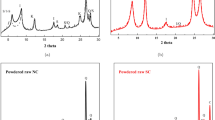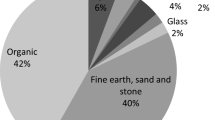Abstract
Limited amounts of industrial residues are recycled while the remaining huge quantities are stockpiled or disposed of, thus frequently leading to soil contamination. The utilization of industrial residues as valuable secondary resources into ceramics can contribute to efficient waste management and substitution for massive amounts of natural resources (clayey minerals) demanded for ceramic production. The low cost of these residues and even possible energy savings during mixture firing may also be beneficial. In the present study, the innovative combination of lignite fly ash with steel-making dust into clay-based red ceramics is undertaken, to contribute both to sustainable use of resources and prevention of soil contamination. Brick specimens were shaped by extrusion and fired, their microstructure was examined and the effect of the mixture composition and firing temperature on physico-mechanical properties was determined. Ceramic microstructures were successfully obtained by a suitable combination of fly ash with steel dust (5 + 5 wt%) into clays. Properties can be predicted and tailored to meet the needs for specific applications by appropriately adjusting the mixture composition and sintering temperature.




Similar content being viewed by others
References
Ahmaruzzaman M (2010) A review on the utilization of fly ash. Prog Energy Combust 36:327–363
Badanoiu A, Voicu G (2011) Influence of raw materials characteristics and processing parameters on the strength of geopolymer cements based on fly ash. Environ Eng Manag J 10(5):673–681
Blissett RS, Rowson NA (2012) A review of the multicomponent utilization of coal fly ash. Fuel 97:1–23
Cikankowitz A, Laforest V (2013) Using BAT performance as an evaluation method of techniques. J Clean Prod 42:141–158
Cultrone G, Sebastián E (2009) Fly ash addition in clayey materials to improve the quality of solid bricks. Constr Build Mater 23:1178–1184
Dermatas D, Vatseris C, Panagiotakis I, Chrysochoou M (2012) Potential contribution of geogenic chromium in groundwater contamination of a Greek heavily industrialized area. Chem Eng Trans 28:217–222
Di Marzio WD, Sáenz ME, Montivero C, Alberdi JL, Tortorelli MC, Ambrini G (2007) Genotoxicity of aqueous elutions of industrial soils. Bull Environ Contam Toxicol 79(5):483–487
Karapanagioti HK, Werner D, Werth CJ (2012) Special issue on sorption and transport processes affecting the fate of environmental pollutants in the subsurface. J Contam Hydrol 129–130:1
Karayannis VG, Moutsatsou AK, Katsika EL (2012) Recycling of lignite highly-calcareous fly ash into nickel-based composites. Fresenius Environ Bull 21(8b):2375–2380
Karayannis V, Moutsatsou A, Koukouzas N, Vasilatos C (2013a) Valorization of CFB-combustion fly ashes as the raw materials in the development of value-added ceramics. Fresenius Environ Bull 22(12c):3873–3879
Karayannis VG, Moutsatsou A, Katsika E (2013b) Synthesis of microwave-sintered ceramics from lignite fly and bottom ashes. J Ceram Process Res 14(1):45–50
Kim JH, Lee KG, Kim Y, Kang SK (2004) Efflorescence and leaching behavior of metal ions for EAF dust-clay based bricks. Mater Sci Forum 449-452(I):241–244
Kockal NU (2012) Utilisation of different types of coal fly ash in the production of ceramic tiles. Bol Soc Esp Ceram Vidr 51(5):297–304
Komnitsas K, Zaharaki D, Perdikatsis V (2009) Effect of synthesis parameters on the compressive strength of low-calcium ferronickel slag inorganic polymers. J Hazard Mater 161(2–3):760–768
Kumar S, Kumar R, Bandopadhyay A (2006) Innovative methodologies for the utilisation of wastes from metallurgical and allied industries. Resour Conserv Recycl 48:301–314
Lis T, Nowacki K (2012) Options of utilising steelmaking dust in a non-metallurgical industry. Metalurgija 51(2):257–260
Machado AT, Valenzuela-Diaz FR, De Souza CAC, De Andrade Lima LRP (2011) Structural ceramics made with clay and steel dust pollutants. Appl Clay Sci 51:503–506
Manara P, Zabaniotou A (2013) Co-pyrolysis of biodiesel-derived glycerol with Greek lignite: a laboratory study. J Anal Appl Pyrol 100:166–172
Milheiro FAC, Freire MN, Silva AGP, Holanda JNF (2005) Densification behaviour of a red firing Brazilian kaolinitic clay. Ceram Int 31:757–763
Mymrin V, Ribeiro RAC, Alekseev K, Zelinskaya E, Tolmacheva N, Catai R (2014) Environment friendly ceramics from hazardous industrial wastes. Ceram Int 40(7A):9427–9437
Porreca P, Furlani E, Fedrizzi L, Brückner S, Minichelli D, Tubaro F, Bachiorrini A, Andreatta F, Maschio S (2007) Sintered ceramics from special waste incinerator ashes and steelmaking slag. Ind Ceram 27:197–203
Quaranta N, Caligaris M, Pelozo G (2011) Emissions analysis from various industrial wastes to be used as raw material for ceramics. WIT Trans Ecol Environ 148:313–323
Raicevic S, Kaludjerovic-Radoicic T, Zouboulis AI (2005) In situ stabilization of toxic metals in polluted soils using phosphates: theoretical prediction and experimental verification. J Hazard Mater 117(1):41–53
Rice RW (1993) Comparison of stress concentration versus minimum solid area based mechanical property-porosity relations. J Mater Sci 28(8):2187–2190
Singh RP, Gupta AK, Ibrahim MH, Mittal AK (2010) Coal fly ash utilization in agriculture: its potential benefits and risks. Rev Environ Sci Biotechnol 9:345–358
Spiliotis X, Ntampegliotis K, Kasiteropoulou D, Lamprakopoulos S, Lolos K, Karayannis V, Papapolymerou G (2014) Valorization of mill scale waste by its incorporation in fired clay bricks. Key Eng Mater 608:8–13
Sun ZJ, Tian ML, Fang YF (2011) Experimental research on mixture ratio and mechanical properties of unburned brick with shell ash and fly ash. Adv Mater Res 250–253:3299–3304
Tsiridis V, Petala M, Samaras P, Kungolos A, Sakellaropoulos GP (2012) Environmental hazard assessment of coal fly ashes using leaching and ecotoxicity tests. Ecotoxiol Environ Saf 84:212–220
Vilches LF, Fernández-Pereira C, Olivares del Valle J, Vale J (2003) Recycling potential of coal fly ash and titanium waste as new fireproof products. Chem Eng J 95:155–161
Xenidis A, Mylona E, Paspaliaris I (2002) Potential use of lignite fly ash for the control of acid generation from sulphidic wastes. Waste Manag 22(6):631–641
Zhang L (2013) Production of bricks from waste materials – a review. Constr Build Mater 47:643–655
Acknowledgments
This research has been co-financed by the European Union (European Social Fund – ESF) and Greek national funds through the Operational Program “Education and Lifelong Learning” of the National Strategic Reference Framework (NSRF) – Research Funding Program ARCHIMEDES III: Investing in knowledge society through the European Social Fund. Also, the authors wish to thank E. Lakioti, PhD, for proofreading the manuscript.
Author information
Authors and Affiliations
Corresponding author
Rights and permissions
About this article
Cite this article
Karayannis, V., Spiliotis, X., Papastergiadis, E. et al. Contribution to the Sustainable Management of Resources by Novel Combination of Industrial Solid Residues into Red Ceramics. Bull Environ Contam Toxicol 94, 345–351 (2015). https://doi.org/10.1007/s00128-014-1446-8
Received:
Accepted:
Published:
Issue Date:
DOI: https://doi.org/10.1007/s00128-014-1446-8




